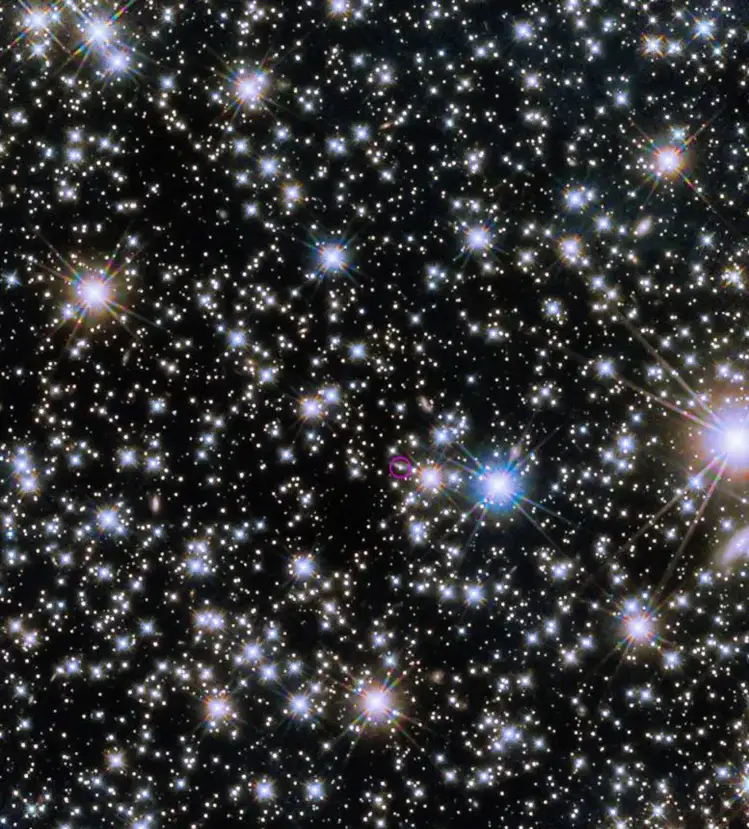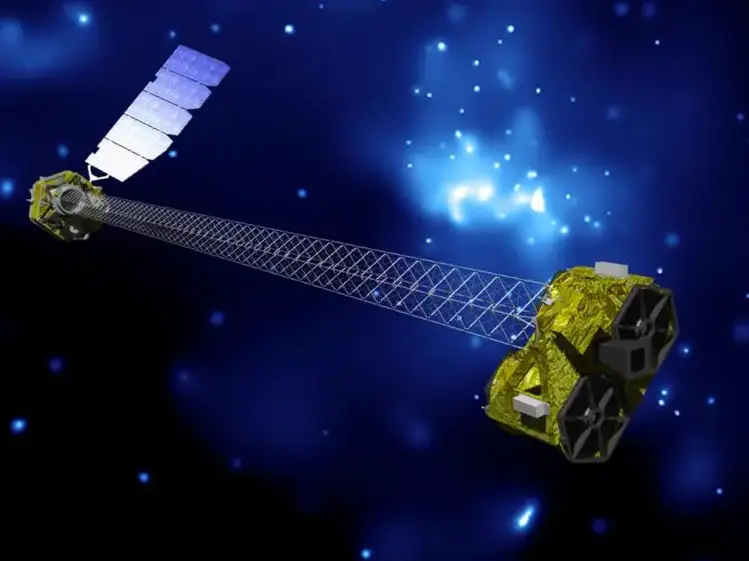Astronomers think GRB 221009A represents the 𝐛𝐢𝐫𝐭𝐡 of a new black hole formed within the heart of a collapsing star. In this illustration, the black hole drives powerful jets of particles traveling near the speed of light. The jets pierce through the star, emitting X-rays and gamma rays as they stream into space. Credit: NASA/Swift/Cruz deWilde

Observations by NASA’s NuSTAR X-ray telescope give astronomers new clues about the brightest and most energetic gamma-ray burst ever detected.
Scientists detected the brightest gamma-ray burst ever, dubbed GRB 221009A or BOAT, in October 2022. Unlike previous gamma-ray bursts, GRB 221009A had a unique jet structure with a narrow core, wider sides, and a variance in energy depending on distance from the core. The unprecedented phenomena observed in the burst were documented by NASA’s NuSTAR observatory and multiple X-ray telescopes.
When scientists detected the gamma-ray burst known as GRB 221009A on October 9, 2022, they dubbed it the brightest of all time, or BOAT. Most gamma-ray bursts occur when the core of a star more massive than our Sun collapses, becoming a black hole. These events regularly release as much energy in a few minutes as our Sun will release in its entire lifetime. Follow-up studies showed that GRB 221009A was 70 times brighter and far more energetic than the previous record holder. While scientists don’t yet understand why, they’ve received a tantalizing clue from NASA’s NuSTAR (Nuclear Spectroscopic Telescope Array) observatory.

A jet of particles pierces a star as it collapses into a black hole during a typical gamma-ray burst, as depicted in this artist’s concept. The jet created by gamma-ray burst 221009A had some unique features. Credit: NASA’s Goddard Space Flight Center
In a study published on June 7, in the journal Science Advances, scientists used NuSTAR observations of the event to show how the collapsing star ejected a jet of material that had a shape not previously observed among gamma-ray burst jets, as well as other unique characteristics. It’s possible that the source of these distinctions is the progenitor star, the physical properties of which could influence the characteristics of the burst. It’s also possible that an entirely different mechanism launches the very brightest jets into space.
The most energetic kind of explosion in the universe, a gamma-ray burst can be spotted billions of light-years away. GRB 221009A was so luminous it effectively blinded most gamma-ray instruments in space when it was detected October 9, 2022. Credit: NASA’s Goddard Space Flight Center
“This event was so much brighter and more energetic than any gamma-ray burst we’ve seen before, it’s not even close,” said Brendan O’Connor, lead author of the new study and an astronomer at George Washington University in Washington. “Then, when we analyzed the NuSTAR data, we realized that it also has this unique jet structure. And that was really exciting, because we have no way of studying the star that produced this event; it’s gone now. But we now have some data giving us clues about how it exploded.”
Jumbo Jet
Gamma rays are the most energetic form of light in the universe yet invisible to the human eye. All known gamma-ray bursts have originated in galaxies outside our Milky Way but are bright enough to be spotted billions of light-years away. Some blink into existence and last less than two seconds, while so-called long gamma-ray bursts typically radiate gamma rays for a minute or more. These objects can radiate other wavelengths for weeks.

The Hubble Space Telescope captured the infrared afterglow (circled) of the gamma-ray burst known as GRB 221009A and its host galaxy. This composite incorporates images taken November 8 and December 4, 2022, about one and two months after the eruption. The afterglow may remain detectable for several years. Credit: NASA, ESA, CSA, STScI, A. Levan (Radboud University); Image Processing: Gladys Kober
GRB 221009A, a long gamma-ray burst, was so bright it effectively blinded most gamma-ray instruments in space. U.S. scientists were able to reconstruct this event with data from NASA’s Fermi Gamma-ray Space Telescope to determine its actual brightness. (The BOAT was also detected by NASA’s Hubble and James Webb space telescopes, the agency’s Wind and Voyager 1 spacecraft, as well as the ESA, or European Space Agency, Solar Orbiter.)
Similar to other gamma-ray bursts, GRB 221009A had a jet that erupted from the collapsing star like it was shot into space from a fire hose, with gamma rays radiating from the hot gas and particles at the jet’s core. But GRB 221009A’s jet stood out in a few ways. In just about every previously observed gamma-ray burst, the jet remained remarkably compact and there was little to no stray light or material outside the narrow beam. (In fact, gamma-ray bursts are so compact, the gamma rays can only be observed when their jets are pointed almost directly at Earth.)

The Fermi Gamma-ray Space Telescope observes the cosmos using the highest-energy form of light, providing an important window into the most extreme phenomena of the universe, from gamma-ray bursts and black-hole jets to pulsars, supernova remnants, and the origin of cosmic rays. Credit: © Daniëlle Futselaar/MPIfR (artsource.nl)
By contrast, in GRB 221009A the jet had a narrow core with wider, sloping sides. Some of the most energetic gamma-ray jets have shown similar properties, but the jet from the BOAT was unique in one important way: The energy of the material in GRB 221009A also varied, meaning that instead of all the material in the jet having the same energy – like a single bullet shot from a gun – the energy of the of the material changed with distance from the jet’s core. This has never been observed in a long gamma-ray burst jet before.
“The only way to produce a different jet structure and vary the energy is to vary some property of the star that exploded, like its size, mass, density, or magnetic field,” said Eleonora Troja, a professor of physics at the University of Rome, who led NuSTAR the observations of the event. “That’s because the jet has to basically force its way out of the star. So, for example, the amount of resistance it meets would potentially influence the features of the jet.”

Artist’s concept of NuSTAR on orbit. Credit: NASA/JPL-Caltech
Footprints in the Snow
Astronomers can see the light from gamma-ray jets, but the distance means they can’t resolve images of the jets directly. Researchers have to interpret the light from these events to learn about the physical characteristics of faraway objects. It’s sort of like looking at footprints in the snow and inferring something about the physical traits of the person who left them.
In many cases, there may be more than one possible explanation for the light from a cosmic event. More than one X-ray telescope observed GRB 221009A, including NASA’s Neil Gehrels Swift Observatory and Neutron star Interior Composition Explorer (NICER), as well as ESA’s XMM-Newton telescope. The NuSTAR data helped narrow down those possibilities. It shows that as the jet traveled into space, it collided with the interstellar medium, or the sparse sea of atoms and particles that fills the space between stars. This collision created X-rays – particles of light slightly less energetic than gamma rays.
“There are multiple X-ray telescopes operating in space, each with different strengths that can help astronomers understand these cosmic objects better,” said Daniel Stern, NuSTAR project scientist at NASA’s Jet Propulsion Laboratory in Southern California.
Reference: “A structured jet explains the extreme GRB 221009A” by Brendan O’Connor, Eleonora Troja, Geoffrey Ryan, Paz Beniamini, Hendrik van Eerten, Jonathan Granot, Simone Dichiara, Roberto Ricci, Vladimir Lipunov, James H. Gillanders, Ramandeep Gill, Michael Moss, Shreya Anand, Igor Andreoni, Rosa L. Becerra, David A. H. Buckley, Nathaniel R. Butler, Stephen B. Cenko, Aristarkh Chasovnikov, Joseph Durbak, Carlos Francile, Erica Hammerstein, Alexander J. van der Horst, Mansi M. Kasliwal, Chryssa Kouveliotou, Alexander S. Kutyrev, William H. Lee, Gokul P. Srinivasaragavan, Vladislav Topolev, Alan M. Watson, Yuhan Yang and Kirill Zhirkov, 7 June 2023, Science Advances.DOI: 10.1126/sciadv.adi1405
More About the Mission
A Small Explorer mission led by Caltech and managed by the Jet Propulsion Laboratory (JPL) for NASA’s Science Mission Directorate in Washington, NuSTAR was developed in partnership with the Danish Technical University and the Italian Space Agency (ASI). The spacecraft was built by Orbital Sciences Corp. in Dulles, Virginia. NuSTAR’s mission operations center is at the University of California, Berkeley, and the official data archive is at NASA’s High Energy Astrophysics Science Archive Research Center at the agency’s Goddard Space Flight Center in Greenbelt, Maryland. ASI provides the mission’s ground station and a mirror data archive. Caltech manages JPL for NASA.





